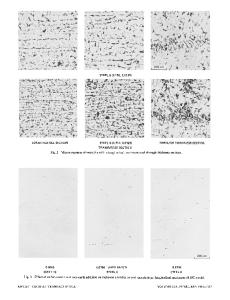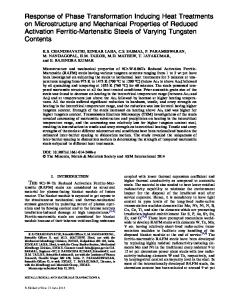Pearlite in ultrahigh carbon steels: Heat treatments and mechanical properties
- PDF / 2,903,347 Bytes
- 8 Pages / 597.28 x 777.28 pts Page_size
- 96 Downloads / 403 Views
I.
INTRODUCTION
ULTRAHIGH carbon steels (UHCS), which are hypereutectoid steels, have been a topic of much interest for their unique mechanical properties. Particularly of recent interest are the high strengths which UHCS materials exhibit. A majority of the studies conceming room-temperature strength in UHCS alloys have concentrated on fully spheroidized microstructures,v,2] Another microstructural condition yielding interesting mechanical properties at room temperature is pearlite, which can be formed by heat treatment from a spheroidized microstructure. Because UHCS materials tie in the hypereutectoid region of the Fe-C phase diagram, the pearlite transformation is different from that in hypoeutectoid steels. In austenitizing unalloyed UHCS, the amount of carbon dissolved in austenite can be varied from the eutectoid composition of 0.77 wt pet at the A~ temperature to a maximum of 2.1 wt pet at the Acre temperature at the E point (the point of maximum solubility of carbon in anstenite). Upon air cooling of UHCS below the A~ temperature, anstenite with dissolved carbon is converted into pearlite. As the amount of carbon dissolved in anstenite is increased, fewer cementite particles will be remined from the original spheroidized microstructure and their sizes will be smaller. An increase in the amount of carbon dissolved in austenite prior to transformation will result in a decrease in the interlamellar spacing of the transformed pearlite. In austenite at or below the A~ transformation temperature, an increase in dissolved carbon increases the driving force for pearlite formation, resulting in a decrease of the interlamellar spacing for nucleated pearlite. This process also allows for the creation of various
ERIC M. TALEFF, Assistant Professor, is with the Department of Aerospace Engineering and Engineering Mechanics, The University of Texas at Austin, Austin, TX 78712-1085. CHOL K. SYN, Engineer/Materials Scientist, and DONALD R. LESUER, Group Leader/Materials Engineer, are with the Manufacturing and Materials Engineering Division, Lawrence Livermore National Laboratory, Livermore, CA 94550. OLEG D. SHERBY, Professor, is with the Department of Materials Science and Engineering, Stanford University, Stanford, CA 94305. Manuscript submitted January 9, 1995.
METALLURGICALAND MATERIALS TRANSACTIONS A
ratios of spheroidized carbide to lamellar pearlitic carbide from an initially spheroidized microstructure. The two alloys studied contain 1.5 wt pet C (UHCS1.5C) and 1.8 wt pet C (UHCS-1.8C). Each alloy also contains 1.6 wt pct A1, 1.5 wt pct Cr, and 0.5 wt pct Mn. The addition of Mn minimizes the deleterious effects of sulfur and phosphorus. The addition of Cr helps to prevent graphitization and stabilizes the carbides, making coarsening more difficult. The addition of A1 inhibits the formation of a hypereutectoid carbide network and stabilizes the ferrite phase. The addition of 1.6 wt pet A1 raises the A~ transformation temperature from 727 ~ to approximately 780 ~ Figure 1 shows an approximation of the Fe-C phas
Data Loading...











